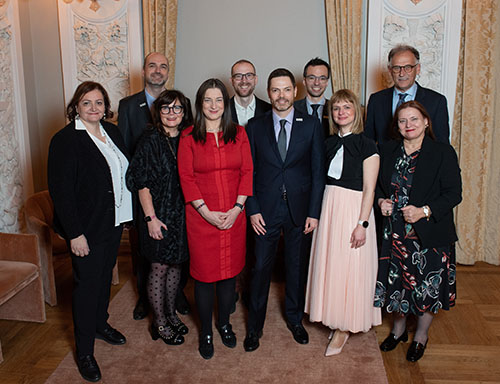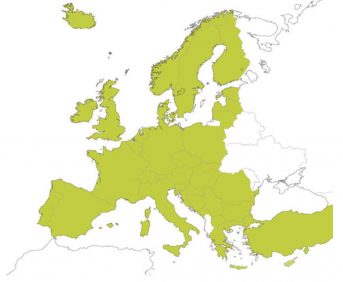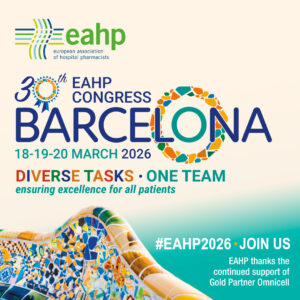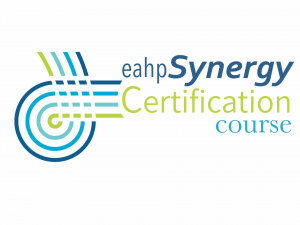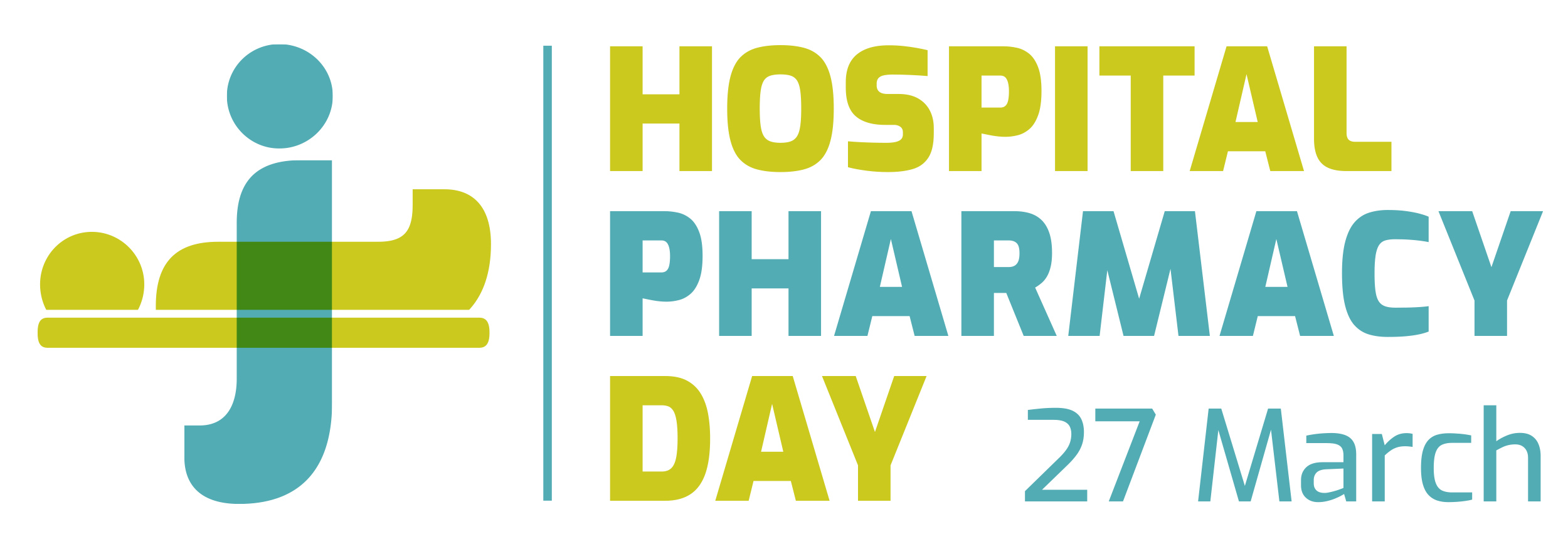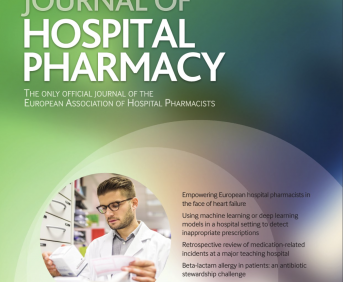DEVELOPMENT AND IMPLEMENTATION OF A PRE-EXPOSURE HIV PROPHYLAXIS DISPENSATION PROGRAM
European Statement
Clinical Pharmacy Services
Author(s)
Natalia Toledo Noda, Víctor Quesada Marqués, Laura Majuelos Aicart, Milagros Varela González, Maria Victoria Morales León
Why was it done?
Despite advances in the control of HIV infection, the number of people who become infected annually in the island (European ultra-periphery region) remains high. The implementation of a PrEP dispensing program would prevent many of these infections since it is known that there is a high number of undiagnosed infected people. In addition, the implementation would allow legally access to this therapy, being an effective, cheap and easily to use therapy.
What was done?
Development and implementation of a medication dispensing program for HIV pre-exposure prophylaxis (PrEP) in adults.
How was it done?
In 2016, the European Medicines Agency authorized the indication of tenofovir disoproxil fumarate 245mg + emtricitabine 200mg as a preventive treatment. In December 2019 the Ministry of Health incorporated it into the National Health System for people who met certain minimum criteria. The hospital was formed since then with the aim of establishing a prescription and dispensing circuit.
What has been achieved?
The following circuit was established:
1. The primary care physician will screen candidates who want to apply to the program and request an initial study. If the candidate meets the criteria, he will consult the infectious diseases unit.
2. The unit value the entry into the program and carry out clinical follow-up. The request for outpatient dispensing is generated for the Pharmacy Service.
3. The Pharmacy Service informs about how to take the medication and its adverse effects. It is dispensed for a maximum period of 3 months. If any problem related to the drug or lack of adherence is detected, it will be communicated to the doctor.
4. A clinical and analytical follow-up is carried out every 3 months to assess the correct use of the medication as well as the appearance of safety problems (renal function and bone involvement). The continuity in the program is evaluated annually.
Since then, the Pharmacy Service has dispensed medication to 20 users and only one discontinued due to lack of adherence.
What next?
Achieve a reduction in the incidence of HIV, which for years has remained stable. Contribute to generate data that support the efficacy and safety of these therapies in real life. Avoid the illegal sale of these drugs.
DEVELOPMENT AND IMPLEMENTATION OF A CAR-T CELL THERAPY PROGRAM IN ADULTS
European Statement
Clinical Pharmacy Services
Author(s)
Natalia Toledo Noda, Víctor Quesada Marqués, María Leonor Oliva Hernández, Nayra Sangil Monroy, Marta María Piñero González, María Victoria Morales León
Why was it done?
The implementation would allow access to this novel therapy to patients who have already exhausted all lines of treatment. The Ministry of Health decides to establish an administration point in the hospital, since due to its geographical location (European ultra-periphery) it would avoid the transfer of patients to other reference centers.
What was done?
Development and implementation of a CAR-T cell therapy administration program in adults.
How was it done?
In November 2018, the Ministry of Health authorized the center to use CAR-T treatment in adult patients with relapsed or refractory diffuse large B-cell lymphoma or with B-cell acute lymphoblastic leukemia. The hospital was prepared to meet specific quality criteria (JACIE Accreditation). Interhospital protocols were developed for the referral, transport, and study of candidate patients from other centers.
What has been achieved?
1. A multidisciplinary team was created made up of professionals from Hematology, Intensive Care Medicine, Neurology and Pharmacy Services, with the aim of assessing candidate patients. A qualified team oversees the clinical management, follow-up, analysis of adverse effects and results obtained.
2. The professionals involved were trained to ensure safe administration and to identify and treat possible complications.
3. Due to the special storage conditions of the drug, a circuit was established. It is storage in the Hematology Service under the supervision of the hospital pharmacist specialized in onco-hematology.
4. One of the most frequent complications of the therapy is cytokine release syndrome. Depending on the gravity, drugs such as tocilizumab should be given as soon as possible. To ensure its availability, the Pharmacy Service permanently reserves two doses. At the time of performing a CAR-T, the automated dispensing system of the hematology ward is provided with the first dose, along with a preparation sheet and its corresponding label in order not to delay its administration. The second dose remains in the Pharmacy Service.
To date, 8 infusions have been made. 100% of the patients had diffuse large B-cell non-Hodgkin lymphoma.
What next?
Facilitate access to this therapy to more patients. Generate data that support its efficacy and safety in real life.
Obtain the accreditation of the center to use the new therapies authorized by the European Medicines Agency.
Implementation of a tool for annual quality assessment of drug information provided by hospital pharmacies
European Statement
Clinical Pharmacy Services
Author(s)
Dorothea Strobach, Ute Chiriac, Sigrun Klausner, Claudia Langebrake, Christiane Querbach, Carolin Schuhmacher
Why was it done?
Although guidelines for DI demand regular quality assurance procedures, no method of evaluation is internationally agreed on. The tool should be feasible, reproducible and reflect real-life quality of DI. It should allow to identify areas for quality improvement in general and for every participant.
What was done?
We developed a tool for annual quality assessment of drug information (DI) provided by hospital pharmacies on behalf of the German Association of Hospital Pharmacists ADKA e.V.. The tool has been successfully implemented for four years.
How was it done?
We developed a new tool for quality assessment of DI using a fictitious test enquiry and simulated real-life conditions and proved it representative for real-life quality [1]. The answers for the test enquiry are evaluated by blinded experts for content and formal requirements. For four years, 2017-2020, annual assessment of DI was offered to German language hospital pharmacies with changing topics and enquiry levels. Participants receive their own result in comparison to average of all regarding content-related and formal requirements. A proposal for an answer is published afterwards for educational purposes.
What has been achieved?
The annual DI quality assessment tool was successfully implemented as shown by increasing numbers of participating hospital pharmacies (45/71/79/118). Areas for improvement have been identified in general and can be identified by each participant as well. As an example, presentation of references has improved over the years [2]. Since 2018, a certificate of participation is offered as document for quality assurance audits thereby underlining the importance of this hospital pharmacy service.
What next?
Annual quality assessment for DI by hospital pharmacies will be further offered. Results over years will be evaluated for overall effect of the annual test tool on quality improvement regarding content-related and formal requirements. This method for annual quality assessment of DI provided by hospital pharmacies could be implemented by other countries.
References
1. Strobach D et al. EJHP 2020 online ahead of print. doi: 10.1136/ejhpharm-2020-002409
2. Strobach D et al. Krankenhauspharmazie 2020;41:187-91
TELEPHARMACY PROGRAMME IN CHRONIC NEUROLOGICAL PATIENTS DURING THE COVID PANDEMIC
Pdf

European Statement
Clinical Pharmacy Services
Author(s)
ROSARIO MORA-SANTIAGO, JOSE-LUIS ORTIZ-LATORRE, ELENA SANCHEZ-YANEZ, ANGEL JURADO-ROMERO, ISABEL MOYA-CARMONA
Why was it done?
During the health alert caused by Covid-19, home delivery was quickly implemented in our country to reduce attendance at the Hospital Pharmacy Service (HPS) to obtain their medications.
In our HPS we transform home delivery into telepharmacy program (TP) with chronic neurological patients, who suffering pathologies that decrease their autonomy, with the purpose to optimize clinical outcomes and reduce the risk of contagion.
What was done?
The main purpose was to design a telepharmacy program (TP) undertstood as the provision of pharmaceutical care by pharmacists through the use of telecommunications to patients located at a distance. Telepharmacy services include patient follow-up and clinical service delivery. In our case, home delivery is also included.
How was it done?
We design the TP stratifying stable chronic patients (more than 6 months of treatment) by level of autonomy, physical distance to our Hospital and high risk (due to immunosuppressive treatment). Inclusion in the TP was proposed to patients with multiple sclerosis (MS) and aminotrophic lateral sclerosis (ALS).
Telepharmacy appointments were recorded and scheduled within the outpatient care activity, they were recorded in the patient’s medical history, as a pharmaceutical clinical follow-up, reviewing adherence, interactions and possible adverse events. Later, home delivery was made, through an external logistics company. Patients gave their consent to transfer personal data for home delivery.
Data collected were: sex and age, first or second line treatment in MS patients, pharmaceutical form (pill or syrup ) in ALS patients and number of total deliveries made.
What has been achieved?
We started on April 2020 with the program, six months later 56 patients were included, 48 with MS (total of MS patients attended by our HPS: 296) and 8 with ALS ( total of ALS patient attended by our HPS: 58). Median age: 45 years in MS group and 65 in ALS group. In MS group 37 patients received 1st line treatment and 10 second line. In ALS patients 6 received tablets and 2 syrup.
420 deliveries took place (average: 3,1 for patient).
What next?
The implementation of the TP was well accepted, avoiding longed displacement in patients with neurological pathologies. Our future target is to reach a greater number of patients that can be included in the program.
AN ITERATIVE APPROACH TO THE DEVELOPMENT OF PHARMACOLOGICAL MANAGEMENT GUIDELINES FOR THE TREATMENT OF PAEDIATRIC INFLAMMATORY MULTISYSTEM SYNDROME – TEMPORALLY ASSOCIATED WITH SARS-CoV-2
European Statement
Clinical Pharmacy Services
Author(s)
CAROL ANN JONES, NANNA CHRISTIANSEN
Why was it done?
Starting in mid-April 2020 as a result of the Coronavirus pandemic, a cluster of patients displaying multisystem inflammation and shock were admitted to our hospital. Similar cohorts have subsequently been reported internationally. Over a 6 week period, in which our institution cared for over 70 children with the newly described PIMS-TS, we developed new pharmacological treatment guidelines. Due to the novelty of the disease, treatment options were unclear and decisions were made by a multidisciplinary team (MDT) of clinicians and pharmacists.
What was done?
This good practice initiative describes the rapid and iterative development of a treatment pathway for the newly described Paediatric Inflammatory Multisystem Syndrome – Temporally associated with SARS-CoV-2 (PIMS-TS). Due to the similarity to Kawasaki disease and septic shock, the routine treatments for these conditions were considered as well as the experience of our adult colleagues, especially in terms of anticoagulation and hyper-inflammation seen in patients presenting with COVID-19. This ensured holistic management plans could be made to provide the highest quality of care.
How was it done?
A MDT of clinicians (intensivists, infectious diseases, cardiologists, rheumatologist, haematologists, endocrinologists) and pharmacists arranged daily meetings to discuss admitted patients as well as pulling together information to formulate a treatment guideline to enable the safe management of these patients. Version one of the treatment pathway was approved in April 2020, by beginning of June version 6 was published. The final treatment pathway included intravenous (IV) immunoglobulin, IV methylprednisolone, aspirin, venous thromboembolism (VTE) prophylaxis and immunomodulation therapy including tocilizumab, infliximab and anakinra.
What has been achieved?
A total of 74 patients have been successfully treated against the treatment pathway, and discharged from hospital. Managing a new condition with no published evidence on treatment was a huge challenge, especially given the large numbers and high acuity of patients. Collaborative learning and reflection has enabled us to develop a robust treatment pathway for our patients. We have witnessed MDT working at its best, united with the sole aim of combating this rare condition.
What next?
An ongoing coordinated effort is required to undertake paediatric research to understand PIMS-TS and establish the most effective treatment for this novel disease.
TELEMEDICINE AND HOMEDELIVERY: MANAGEMENT OF THERAPEUTIC CONTINUITY IN THE PANDEMIC ERA.
Pdf

European Statement
Clinical Pharmacy Services
Author(s)
Marta Del Vecchio, Federica Chinotti , Claudia Lauria Pantano, Elirosa Minniti, Erika Cataldo, Francesco Guidoni, Vito Ladisa
Why was it done?
The Severe Acute Respiratory Syndrome – Coronavirus – 2 (SARS-CoV-2 ) pandemic made it difficult to monitor the patient’s health condition because many of them were locked down at home, unable to attend routine hospital visits.
What was done?
The hospital pharmacist, focusing on therapeutic continuity, closely collaborated with the clinicians in monitoring patient’s condition using telemedicine and homedelivery services.
How was it done?
In the multidisciplinary team, the pharmacist and the clinician defined the criteria to choose the most suitable patients for the homedelivery service. One of the options was to dispense the drug in a neighboring hospital. Because of the sanitary system regionalization, some of those hospitals could have been located even more than 100 km away, resulting in a problem for the most critical patients. In order to help them, home delivery and telemedicine services has been considered. The clinician used to visit patients on digital platforms, making clinical evaluations based on the results of blood tests, diagnostic tests and imaging techniques. According to clinician’s indications, the pharmacist took contact with patients, in first to collect informations about any residual storage of the drugs, adverse reactions, therapeutic compliance and then to proceed with the delivery. Everything has been done in conformity with the General data protection regulation (GDPR).
What has been achieved?
From March to September 2020, the homedlivery service count 501 speditions all over the Nation, 480 patients has been contacted to recive therapy and 250 of them has been intensively monitored by calling to manage their follow up. Everything has been done in order to protect critical patients from pandemic, safeguarding the therapeutic continuity,in compliance with pharmacovigilance, risk managment and cost saving for the national health system, considering that the suspension of therapies could be considered an additional and not quantifiable cost, but certainly important.
What next?
The hospital pharmacist must collaborate ever more with the clinician even in the post-pandemic phase, remotely managing not only the most weak patients, but extending the telemedicine and homedelivery services to an increasing number of patients, in order to safeguard their health .
IMPLEMENTATION OF A SAFE EXTERNAL DISPENSING SYSTEM DURING THE COVID-19 PANDEMIC IN A REFERRAL HOSPITAL
Pdf

European Statement
Clinical Pharmacy Services
Author(s)
MARINA CORRALES PAZ, CLAUDIA RODRIGUEZ MORETA, INMACULADA LOMARES MANZANO, ANA GANFORNINA ANDRADES
Why was it done?
Due to the health crisis caused by the SARS-COV-2 virus, many hospitals have seen
the necessity to implement a safe dispensing system (telepharmacy) to provide medication to
high risk patients and those infected with Covid-19 in order to prevent interrupting their
treatments.
What was done?
To implement a system that guarantees a sure and effective supply of medical treatments to those vulnerable patients, those at increased risk or with difficult access to the hospital during the coronavirus pandemic.
How was it done?
A database was created with those patients attending our hospital’s outpatient service(OS)to pick up their medication within the next 7 days, verifying through pharmaceutical software and the patient’s medical history records (MHR)their next dispensing date. After checking if the patient had a medical appointmentthat could coincide with the dispensing date, a phone interview was conducted with the patient to schedule the pick-up of the medication through theOS or by telepharmacy(patients’ consent was requiredto use their personal information and we asked how the treatment was going). In our case the patients could pick-up their medication in the referral hospital (RH), a newly created OS in an affiliate hospital or by telepharmacy toprevent the collapse of the hospitals. We registered: number of patients attended in RH, new OS or by telepharmacy and number of dispensations. Patients were grouped in areas based on their city and delivery date for telepharmacy and in the case of patients picking up their own medication they were made an appointment.
What has been achieved?
During the months the state of emergency was in place in Spain (March 14th– June 21st)3385 patients were attended in total and 9316 medicationswere dispensed. 2245(66.3%) patients were attended in the RH (5794 dispensations), 583(17.2%) patients were attended through the new OS (1436 dispensations) and the rest 557(16.5%) had their medication sent to their address (2086 dispensations).
What next?
A safe and effective dispensing system was achieved to outpatients during the Covid-19 pandemic through the implementation of a new telepharmacymethod and the establishment of a new OSthat allows convenient dispensation of medication while minimising the risk of virus spread.
IMPLANTATION OF A PHARMACEUTICAL CARE AND HOME DELIVERY CIRCUIT FOR OUTPATIENTS DURING THE ALARM STATE FOR COVID-19
Pdf

European Statement
Clinical Pharmacy Services
Author(s)
ROCÍO TAMAYO BERMEJO, ARANZAZU LINARES ALARCÓN, CASILDA ORTEGA DE LA CRUZ, ISABEL MUÑOZ CASTILLO
Why was it done?
In the alarm state due to COVID-19 in March 2020, in order to reduce the number of visits to the hospital to outpatients who go to the Outpatient Pharmaceutical Care Area, a new Pharmaceutical Care and home delivery circuit is implemented.
What was done?
A circuit of Pharmaceutical Care and home delivery was implemented for outpatients in the alarm state due to COVID-19.
How was it done?
The needs, possibilities and resources of the Hospital were identified. Material resources were adapted: supply and stock management. A logistical solution was sought and a review of thermolabile drug stabilities was made. Human resources were restructured: definition of a new team, functions and responsibilities.
A new circuit was implemented with remote access. When the patient contacts, he´s attended by a pharmacist who performs the screening and interview (initiation/follow-up), who after reviewing the clinical records, validates the treatment and selects the dispensing process of the patient according to individualized. The preparation of shipments is organized through the use of a web resource, by a pharmacy technician and at a specific time, based on a list of shipments per day, dispensing sheets and personalized labels. Once the dispensations have been prepared, a double check is made by another pharmacy technician on a different shift.
Three phone lines and an email weren´t enough to attend to all concurrents demands in a period of less than 24 hours. To mitigate this situation, a multichannel information strategy was implemented to notify all patients.
Other limitations: incidents by the logistic operator, errors in addresses and incorrect dose shipments.
What has been achieved?
During two months (April-May), 1103 patients benefited from the new circuit, approximately 30% of the patients who collect medication in our Outpatient Pharmaceutical Care Area during this period.
What next?
The pharmaceutical care and home delivery circuit has been shown to be safe, and has been able to meet the needs that are required in a alarm state. Also, it´s a circuit applicable to other Pharmacy Deparments since it doesn´t require a large investment in resources.
MEDICATION MANAGEMENT OF COMBINATION THERAPY IVACAFTOR , TEZACAFTOR AND ELEXACAFTOR FOR CYSTIC FIBROSIS PATIENTS WITH THE F508del MUTATION BY THE HOSPITAL PHARMACY IN A CENTRAL GENERAL HOSPITAL
Pdf

European Statement
Clinical Pharmacy Services
Author(s)
DESPOINA MAKRIDAKI, KALLIOPI ALLAGIANNI, NIKOLAOS SKORDAS
Why was it done?
In our hospital is located the main CF Unit for Adults in the country. Ensuring that as many as possible young patients benefit from accessing the new and crucial treatment, even during COVID-19 period, reflects our commitment to improve patients’ outcomes and overall survival,
What was done?
A Phase 3, open-label clinical trial (CT) with 3 enrolled patients runs since April 2019 and two early access (EA) programs with 23 enrolled patients run since the end of July 2020 to permit the access of cystic fibrosis (CF) patients with the F508del mutation in the innovative combination therapy of ivacaftor, tezacaftor and elexacaftor (IVA/TEZA/ELEXA) in our hospital.
How was it done?
3 outpatients enrolled in the CT and procedures regarding the protocol have been followed strictly. Medication dispensing is conducted every 12 weeks.
In the EA procedure, 2 parallel programs have been approved by authorities, one for the homozygous including 19 patients and one for the heterozygous including 4 patients. Dispensing is programmed every 4 weeks, although an initial stock for 3 months was shipped to pharmacy.
The role of HPs was decisive for the quick start of the EA programs during COVID-19 period. Roadmap was designed at the beginning by HPs in collaboration with the physicians to accelerate approval and shipment procedures and also regarding licensing for each patient, drug receipt, storage, dispensing, accountability, electronic registry in designated EA platform and additional electronic recording and follow up in the electronic Pharmacy platform for both the IVA/TEZA/ELEXA and supporting therapies (e.g. inhaled antibiotics, a-dornase)
For 17 EA patients with chronic obstructive pulmonary disease in exacerbation, hospitalization before starting the IVA/TEZA/ELEXA therapy was necessary. HPs monitored closely their cartexes to avoid adverse reactions and delays in therapy.
HPs served all outpatients on personal afternoon appointments, to avoid overcrowding in the hospital during the pandemic.
What has been achieved?
Critically ill patients have been able to receive in priority the IVA/TEZA/ELEXA treatment, without cost, and valuable scientific experience has been gained.
What next?
EA programs have received 3 months extension until reimbursement negotiations are completed by authorities. In the meantime, we design a cost affordable procedure to ensure continuity of access for our patients.
HOME DELIVERY OF DRUGS, A DISPENSING SYSTEM THAT HAS COME TO STAY
Pdf

European Statement
Clinical Pharmacy Services
Author(s)
Ignacio Salar Valverde, Maria García Coronel, Consolacion Pastor Mondéjar, Mayte Gil Candel, Iris Muñoz Garcia, Carles Iniesta Navalon, Elena Urbieta Sanz
Why was it done?
This project was carried out to avoid the possibility of contagion by SARS-CoV-2 when going to collect the medication. The circuit began at the end of March and the month of April 2020.
What was done?
Send the hospital dispensing medication to the patient’s home.
How was it done?
The first step was to specify the patient was considered at risk for SARS-CoV-2, in the end, patients over 65 years of age or immunosuppressed were considered at risk.
The second step was what order to follow to select and evaluate candidate patients for home delivery, for which the solution was simple, it was decided to follow the order of the pharmacy agenda for the collection of medication. The SELENE® electronic medical record program was used to evaluate the patient’s risk.
The third step was to contact him by phone, to check if there was a possibility of collecting the medication by a family member / caregiver, and if not, confirm a delivery address.
The last step was the preparation of the medication in the proper conditions of conservation and identified with the name and address of the patient. Shipments were organized from the pharmacy service. Patients were given an appointment in the pharmacy agenda for the next shipment.
What has been achieved?
There were 139 home deliveries of medication, 47 in March and 92 in April. Around 139 telephone calls were made, they are not counted, not all patients could be contacted in the first attempt, and up to three attempts were made per patient.
The majority, 124 shipments, were made through the service that the hospital made available to them, except for 13 that were made through the Red-Cross and 2 through Civil-Protection.
What next?
Although the delivery of medication at home and was already carried out in some pharmacy services, because of the pandemic it has spread to the rest of the hospitals in our country.
This service should be maintained, despite its cost, for patients who meet a series of criteria, which must be established and agreed upon. In addition, a telephone follow-up should be carried out on the patients that we send the medication to their home.
